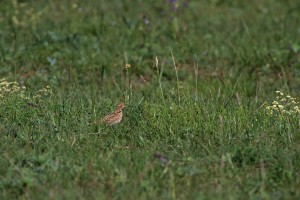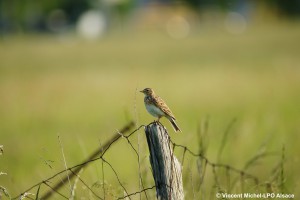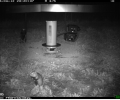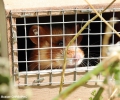From counting skylarks to European Hamsters
7 février 2019
From 2014 to 2017, the LPO Alsace (Bird Protection League) contributed to the Life+ ALISTERprogramme set up to deal with declining populations of the European Hamster (Cricetus cricetus), by monitoring the Eurasian Skylark (Alauda arvensis). The aim of this was to assess the impact of protective measures taken for the European Hamster on the nesting and migratory stopovers of the skylarks.
A census of skylark couples was carried out in spring in areas of 100 ha on average, including plots of land with agricultural measures in favour of the European Hamster, as well as on control sectors without measures. An autumn staging count of the species was also carried out on the same plots.
During the 4 years of the programme, 8 areas of 100 ha were monitored in spring and autumn.
The breeding pair concentrations, although very different depending on the areas, were analysed using statistical tools. In this way, the study highlighted:
-
a positive correlation between the size of the plots and the concentrationof the skylark population: The smaller the plots of farming land, the higher is the population density. The positive impact of the smaller plots, which increase the number of field borders (edge effect), has already been established for an abundance of pollinating insects and plants (Hass & al., 2018).
-
a low concentrationof skylarks in all the monitored areas: In Europe, the territorial area of skylarks varies between 0.17 and 4.6 ha (1980-1990 period – Géroudet and Cuisin, 1998). Whereas in the case of this study for 2015, the territorial area varies between 5.29 and 12.06 ha. This low level can be explained by the general disappearance of the bird’s habitat, but also by road traffic that causes a high level of noise disturbance during nesting periods (Buxton R. T. et al., 2017). Most of the monitored sites were located near motorways.
-
a positive impact on agricultural measures in favour of hamsters on the skylark concentration (24% of a given area must be put into clover, alfalfa and wheat).
-
In addition, monitoring migration shows that the plots with measures were not visited during migratory stopovers throughout the duration of the study, as the crop cover is too dense for the species. A study (Eraud & Corda, 2004) on the night-time use of the plots in winter showed that there were more skylarks when the vegetation reached a height of between 1 and 10 cm and when vegetation ground cover was between 10 and 75%. Conversely, plots devoid of vegetation were avoided, which therefore means that ploughing has an adverse effect.
So this experience has led to proposals that will benefit the whole faunistic category in farming environments:

-
To further reduce the size of agricultural plots
-
To increase the amount of favourable and very favourable crops and fallow land
-
To phase out the use of pesticides
-
Not to leave the land bare in autumn and winter
-
To create ‘squares for skylarks1 ‘to increase the edge effect


![Congratulations Nathalie Arnold, a Chevalier de l’ordre du Mérite Agricole [A Knight of Agricultural Merit].](https://www.grand-hamster-alsace.eu/wp-content/uploads/2016/12/medaille-120x100.png)


